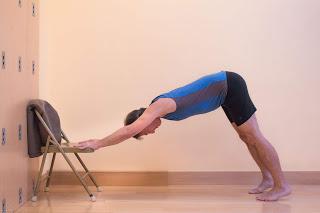 Q: I had a pituitary tumor removed (from under my brain in the pituitary chasm, apparently they are quite common!) 7 years ago. It affected my peripheral vision as the tumor was pressing on the optic nerve. I have fully (?) recovered, including my eyesight. I have done yoga for 34 + years… and recently have been practicing gentle yoga 2-3 times a week. (I'm nearing 69 yrs. old). I had an MRI scan this week and it revealed the tumor is beginning to grow again!! Although it is tiny, I am not quite sure if I should continue inversions ...My question is -- should I be doing down dog, should I be doing inversions...I am not sure if a growth is affected by inversions - worsened or unaffected? I feel no pressure in my head or eyes doing down dog. What do you think? A: First and foremost, I recommend you discuss this question with your neurosurgeon because they are the experts in this area and you should heed their advice. However, in case your doctor is not familiar with yoga or the kind of yoga you do, you might want to bring along a visual aid, such as our book or any other that shows the poses, especially the inversions, that you typically do in your home practice or in your public classes. Remember, inversions are any pose where the heart is above the level of your head, even it is only slightly so. So, this includes poses you might not think of as “inversions,” such as, Standing Forward Bend, Widespread Standing Forward Bend, Bridge pose, Legs Up the Wall pose, and, of course, Downward-Facing Dog. I’d also recommend you tell your doctor how long you typically hold your poses, especially the inversions that you are particularly interested in knowing about, as that will be helpful for them to know. As for advice that I can give, as always, I cannot give you specific health advice but I can give you some general information to consider. To begin with, it is important for all to understand what a pituitary tumor is. Known as pituitary adenomas, these tumors, which are usually non-cancerous, arise from the endocrine tissue of the pituitary gland, the small, pea-sized gland located in the center of the brain that helps maintain hormonal balance of your body (see Why You Should Care About Your HPA Axis for details). In the US alone, there are about 10,000 new cases diagnosed every year, most commonly in older adults. Because the pituitary gland is located by the optic nerve that passes back and forth between the eyes and the back lobe of the brain, the occipital lobe, if a tumor in this small area begins to get bigger, it can press on the optic nerve and disrupt the vision, as happened to our reader when her first tumor began to grow. About a third of pituitary adenomas are “non-functional,” which means they to do not affect the amounts of hormones the pituitary gland secretes. Based on the information we have here, it sounds like our reader fits into this category. However, some pituitary tumors do affect certain hormone producing cells and can throw the normal hormone balance off, resulting in other symptoms. In one case, if the tumor affects the cells that make adrenocortical hormones, high blood pressure can be a side effect. In this specific situation, our recommendations in Lowering Your Blood Pressure on modifying your practice for high blood pressure would apply. Let’s consider first if there are any risk factors for someone developing a second pituitary tumor after a first was found and removed. I did some research and I have not found any mention in the medical literature of specific physical activities, such as yoga, running or general exercise, that put you at higher risk of a recurrence. In fact, I have found no identified risk factors at all. So, if I were in our reader’s shoes I’d feel somewhat reassured that my recent yoga practice had nothing to do with the reappearance of this new small tumor. This also has relevance to our reader’s specific question: Is it generally safe to continue to do inversions, such as Downward-Facing Dog pose, and would it affect tumor growth? To date, I have been unable to find any research on yoga poses and pituitary tumors or studies on the effect of partial or full inversions, either with yoga poses or tilt-table testing, on these kinds of tumor growths.Therefore, we don’t know if it is safe to practice inversions or if they affect tumor growth in any way, either increasing or decreasing it. That noted, if you get the green light from you neurosurgeon to continue practicing yoga asana with no specific restrictions, then I think it would be okay to continue with the gentle yoga practice that already seems to be the mainstay your practice these days, as this is great approach for both physical benefits of yoga and for stress management in this period of uncertainty. If you are still nervous about continuing inversions as you have done them in the past, you could start start by doing variations of the poses that don’t have the head below the heart, such as Half Downward-Facing Dog pose or Legs Up the Wall pose with your pelvis on the ground.
Q: I had a pituitary tumor removed (from under my brain in the pituitary chasm, apparently they are quite common!) 7 years ago. It affected my peripheral vision as the tumor was pressing on the optic nerve. I have fully (?) recovered, including my eyesight. I have done yoga for 34 + years… and recently have been practicing gentle yoga 2-3 times a week. (I'm nearing 69 yrs. old). I had an MRI scan this week and it revealed the tumor is beginning to grow again!! Although it is tiny, I am not quite sure if I should continue inversions ...My question is -- should I be doing down dog, should I be doing inversions...I am not sure if a growth is affected by inversions - worsened or unaffected? I feel no pressure in my head or eyes doing down dog. What do you think? A: First and foremost, I recommend you discuss this question with your neurosurgeon because they are the experts in this area and you should heed their advice. However, in case your doctor is not familiar with yoga or the kind of yoga you do, you might want to bring along a visual aid, such as our book or any other that shows the poses, especially the inversions, that you typically do in your home practice or in your public classes. Remember, inversions are any pose where the heart is above the level of your head, even it is only slightly so. So, this includes poses you might not think of as “inversions,” such as, Standing Forward Bend, Widespread Standing Forward Bend, Bridge pose, Legs Up the Wall pose, and, of course, Downward-Facing Dog. I’d also recommend you tell your doctor how long you typically hold your poses, especially the inversions that you are particularly interested in knowing about, as that will be helpful for them to know. As for advice that I can give, as always, I cannot give you specific health advice but I can give you some general information to consider. To begin with, it is important for all to understand what a pituitary tumor is. Known as pituitary adenomas, these tumors, which are usually non-cancerous, arise from the endocrine tissue of the pituitary gland, the small, pea-sized gland located in the center of the brain that helps maintain hormonal balance of your body (see Why You Should Care About Your HPA Axis for details). In the US alone, there are about 10,000 new cases diagnosed every year, most commonly in older adults. Because the pituitary gland is located by the optic nerve that passes back and forth between the eyes and the back lobe of the brain, the occipital lobe, if a tumor in this small area begins to get bigger, it can press on the optic nerve and disrupt the vision, as happened to our reader when her first tumor began to grow. About a third of pituitary adenomas are “non-functional,” which means they to do not affect the amounts of hormones the pituitary gland secretes. Based on the information we have here, it sounds like our reader fits into this category. However, some pituitary tumors do affect certain hormone producing cells and can throw the normal hormone balance off, resulting in other symptoms. In one case, if the tumor affects the cells that make adrenocortical hormones, high blood pressure can be a side effect. In this specific situation, our recommendations in Lowering Your Blood Pressure on modifying your practice for high blood pressure would apply. Let’s consider first if there are any risk factors for someone developing a second pituitary tumor after a first was found and removed. I did some research and I have not found any mention in the medical literature of specific physical activities, such as yoga, running or general exercise, that put you at higher risk of a recurrence. In fact, I have found no identified risk factors at all. So, if I were in our reader’s shoes I’d feel somewhat reassured that my recent yoga practice had nothing to do with the reappearance of this new small tumor. This also has relevance to our reader’s specific question: Is it generally safe to continue to do inversions, such as Downward-Facing Dog pose, and would it affect tumor growth? To date, I have been unable to find any research on yoga poses and pituitary tumors or studies on the effect of partial or full inversions, either with yoga poses or tilt-table testing, on these kinds of tumor growths.Therefore, we don’t know if it is safe to practice inversions or if they affect tumor growth in any way, either increasing or decreasing it. That noted, if you get the green light from you neurosurgeon to continue practicing yoga asana with no specific restrictions, then I think it would be okay to continue with the gentle yoga practice that already seems to be the mainstay your practice these days, as this is great approach for both physical benefits of yoga and for stress management in this period of uncertainty. If you are still nervous about continuing inversions as you have done them in the past, you could start start by doing variations of the poses that don’t have the head below the heart, such as Half Downward-Facing Dog pose or Legs Up the Wall pose with your pelvis on the ground. 

When you’re comfortable with that you could progress to a milder version of the classic inversion, such as Downward-Facing Dog pose with hands on chair or Legs Up the Wall pose with only a slight lift under your pelvis, which provides a more gradual slope from heart to head. Eventually, you may feel ready to practice the classic pose.

 Since the main issue you will be watching for is any change in your vision, I’d be mindful when doing these poses of any clear changes to your baseline vision during or after practicing the poses. It sounds like our reader is already tuning into this, which is great. One reason it would be beneficial to keep partial inversions in your practice, especially the supported variety, such as Bridge pose with support under the pelvis and Legs Up the Wall with a lift under the pelvis, is that they can have a calming effect on the nervous system, a wonderful benefit when dealing with any health issue!
Since the main issue you will be watching for is any change in your vision, I’d be mindful when doing these poses of any clear changes to your baseline vision during or after practicing the poses. It sounds like our reader is already tuning into this, which is great. One reason it would be beneficial to keep partial inversions in your practice, especially the supported variety, such as Bridge pose with support under the pelvis and Legs Up the Wall with a lift under the pelvis, is that they can have a calming effect on the nervous system, a wonderful benefit when dealing with any health issue!  Also, if for any reason you are not comfortable holding the inversions for longer times, you can always do a dynamic variation of an active pose, such as Dynamic Downward-Facing Dog pose (see youtube.com), as an alternative. —BaxterSubscribe to Yoga for Healthy Aging by Email ° Follow Yoga for Healthy Aging on Facebook and Twitter ° To order Yoga for Healthy Aging: A Guide to Lifelong Well-Being, go to Amazon, Shambhala, Indie Boundor your local bookstore.Follow Baxter Bell, MD on YouTube, Facebook, and Instagram. For upcoming workshops and retreats see Baxter's Workshops and for info on Baxter see baxterbell.com.
Also, if for any reason you are not comfortable holding the inversions for longer times, you can always do a dynamic variation of an active pose, such as Dynamic Downward-Facing Dog pose (see youtube.com), as an alternative. —BaxterSubscribe to Yoga for Healthy Aging by Email ° Follow Yoga for Healthy Aging on Facebook and Twitter ° To order Yoga for Healthy Aging: A Guide to Lifelong Well-Being, go to Amazon, Shambhala, Indie Boundor your local bookstore.Follow Baxter Bell, MD on YouTube, Facebook, and Instagram. For upcoming workshops and retreats see Baxter's Workshops and for info on Baxter see baxterbell.com. 
